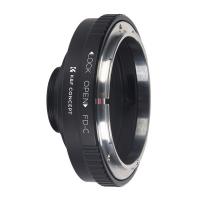How Was The Electron Microscope Invented ?
The electron microscope was invented in 1931 by German physicist Ernst Ruska and his colleague Max Knoll. Ruska had been inspired by the work of German physicist Max von Laue, who had discovered that X-rays could be diffracted by crystals to produce a pattern that could be used to determine the structure of the crystal. Ruska realized that if he could use a beam of electrons instead of X-rays, he could achieve much higher resolution and magnification.
Ruska and Knoll built the first electron microscope by using a beam of electrons to illuminate a sample and then using magnetic lenses to focus the electrons onto a screen or photographic plate. The resulting image was much more detailed than anything that could be achieved with a traditional light microscope.
The invention of the electron microscope revolutionized the field of microscopy and allowed scientists to study the structure of materials and biological specimens at a much higher level of detail than was previously possible.
1、 Early developments in microscopy

The invention of the electron microscope can be traced back to the early developments in microscopy. In the late 16th century, the first compound microscope was invented, which used two lenses to magnify objects. This was followed by the invention of the single-lens microscope, which was more portable and easier to use. In the 19th century, the development of the light microscope allowed scientists to see even smaller objects, but it had limitations due to the wavelength of visible light.
In the early 20th century, scientists began to experiment with using electrons instead of light to create images of small objects. In 1926, German physicist Ernst Ruska built the first electron microscope, which used a beam of electrons to create a highly magnified image of a small object. This breakthrough allowed scientists to see structures that were too small to be seen with a light microscope.
Since then, electron microscopes have continued to evolve and improve. In the 1930s, transmission electron microscopes were developed, which allowed scientists to see the internal structure of cells and other small objects. In the 1950s, scanning electron microscopes were invented, which allowed scientists to see the surface of objects in three dimensions.
Today, electron microscopes are used in a wide range of fields, including biology, materials science, and nanotechnology. They have revolutionized our understanding of the microscopic world and continue to be an important tool for scientific research.
2、 The invention of the electron microscope

The invention of the electron microscope can be traced back to the early 20th century when scientists were trying to find ways to improve the resolution of microscopes. In 1924, Ernst Ruska, a German physicist, proposed the idea of using electrons instead of light to magnify objects. He collaborated with Max Knoll, an electrical engineer, to build the first electron microscope in 1931.
The electron microscope works by using a beam of electrons instead of light to magnify objects. The electrons are focused using magnetic lenses and then directed onto the sample. The electrons interact with the sample, producing an image that can be viewed on a screen.
The invention of the electron microscope revolutionized the field of microscopy, allowing scientists to see objects at much higher magnifications and resolutions than was previously possible. This led to many new discoveries in fields such as biology, materials science, and nanotechnology.
In recent years, there have been advancements in electron microscopy technology, such as the development of cryo-electron microscopy, which allows for the imaging of biological samples in their natural state. This has led to breakthroughs in the study of protein structures and has the potential to lead to new treatments for diseases.
Overall, the invention of the electron microscope has had a profound impact on science and technology, and continues to be an important tool for researchers today.
3、 Improvements in electron microscope technology

The invention of the electron microscope can be traced back to the early 20th century when scientists were exploring the properties of electrons. In 1924, Louis de Broglie proposed that electrons could behave like waves, which led to the development of electron diffraction techniques. This paved the way for the development of the electron microscope, which uses a beam of electrons instead of light to produce high-resolution images of tiny objects.
The first electron microscope was built in 1931 by Max Knoll and Ernst Ruska, who were awarded the Nobel Prize in Physics in 1986 for their work. The early electron microscopes were limited in their resolution and were only able to produce low-quality images. However, improvements in electron microscope technology over the years have led to significant advances in the field.
One major improvement was the development of the transmission electron microscope (TEM), which uses a thin sample to produce high-resolution images of the internal structure of materials. Another important development was the scanning electron microscope (SEM), which produces images by scanning a beam of electrons across the surface of a sample.
In recent years, advances in electron microscope technology have led to the development of new techniques such as cryo-electron microscopy, which allows scientists to study biological molecules in their natural state. This has led to significant breakthroughs in the field of structural biology, including the determination of the structure of the Zika virus and the development of new drugs to treat diseases such as cancer.
Overall, the invention of the electron microscope and subsequent improvements in technology have revolutionized our understanding of the microscopic world and have led to significant advances in a wide range of scientific fields.
4、 Applications of electron microscopy

How was the electron microscope invented?
The electron microscope was invented in 1931 by German physicist Ernst Ruska and his colleague Max Knoll. Ruska had been working on the idea of using electrons to magnify images since the 1920s, and he and Knoll were able to build the first electron microscope by using a magnetic field to focus a beam of electrons onto a sample. This allowed them to achieve much higher magnification than was possible with traditional optical microscopes, which use light to create images.
Applications of electron microscopy:
Since its invention, the electron microscope has become an essential tool in many fields of science and technology. It is used to study the structure and properties of materials at the atomic and molecular level, and has applications in fields such as materials science, biology, and nanotechnology.
In materials science, electron microscopy is used to study the microstructure of materials, including metals, ceramics, and polymers. This allows researchers to understand how the structure of a material affects its properties, such as strength, conductivity, and durability.
In biology, electron microscopy is used to study the structure of cells and tissues, including viruses, bacteria, and other microorganisms. This allows researchers to understand how these structures function and interact with each other, and can lead to new insights into disease processes and treatments.
In nanotechnology, electron microscopy is used to study the properties of materials at the nanoscale, which is the scale of individual atoms and molecules. This allows researchers to design and create new materials with unique properties, such as increased strength, conductivity, or reactivity.
The latest point of view:
In recent years, advances in electron microscopy have led to new techniques and applications. For example, cryo-electron microscopy (cryo-EM) allows researchers to study biological samples at near-atomic resolution, which has led to new insights into the structure and function of proteins and other biomolecules. In addition, scanning transmission electron microscopy (STEM) allows researchers to study the chemical composition of materials at the nanoscale, which has applications in fields such as catalysis and energy storage. Overall, the electron microscope continues to be a powerful tool for scientific discovery and technological innovation.







































